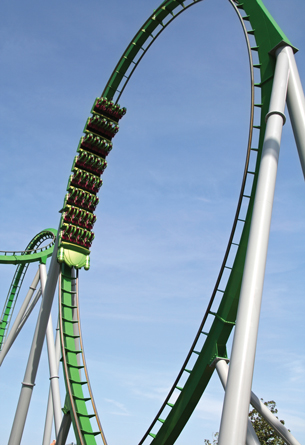Module 5—Circular Motion
Lesson 2—Newton's Laws Applied to Vertical Circular Motion
 Get Focused
Get Focused

© Jim Lopes/shutterstock
Roller coasters can be extremely exciting. At the very top of this loop, at just the right speed, the riders travelling in the roller coaster will feel weightless. A moment later, as the coaster comes to the bottom of the loop, the riders will feel much heavier than usual. This is achieved by dramatic shifts in the net acceleration of the riders, giving them the sensation of changing weight. You may experience the same sensation while riding on a Ferris wheel, although to a lesser extreme. In both cases, understanding the motion and the sensations is based on similar principles.
An application of free-body analysis and Newton’s second law can be used to design vertical loops that maintain a tension that produces just the right amount of acceleration for a good adrenaline rush. What is the right amount of acceleration? What is the difference between the acceleration of the rider at the top of a vertical loop and his or her acceleration at the bottom? How do you design the loop to produce just the right amount of acceleration for the riders?
weightless: experiencing little apparent gravitational pull
tension: a stress that tends to stretch an object
As you work through this lesson, keep these important questions in mind:
- How do Newton’s laws explain the sensations during vertical circular motion, such as in a loop on a roller coaster?
- What forces come into play during vertical circular motion?
 Module 5: Lesson 2 Assignments
Module 5: Lesson 2 Assignments
Your teacher-marked Module 5: Lesson 2 Assignment requires you to submit a response to the following:
- Try This—TR 1, TR 2, TR 3, TR 4, and TR 5
You must decide what to do with the questions that are not marked by the teacher.
Remember that these questions provide you with the practice and feedback that you need to successfully complete this course. You should respond to all the questions and place those answers in your course folder.